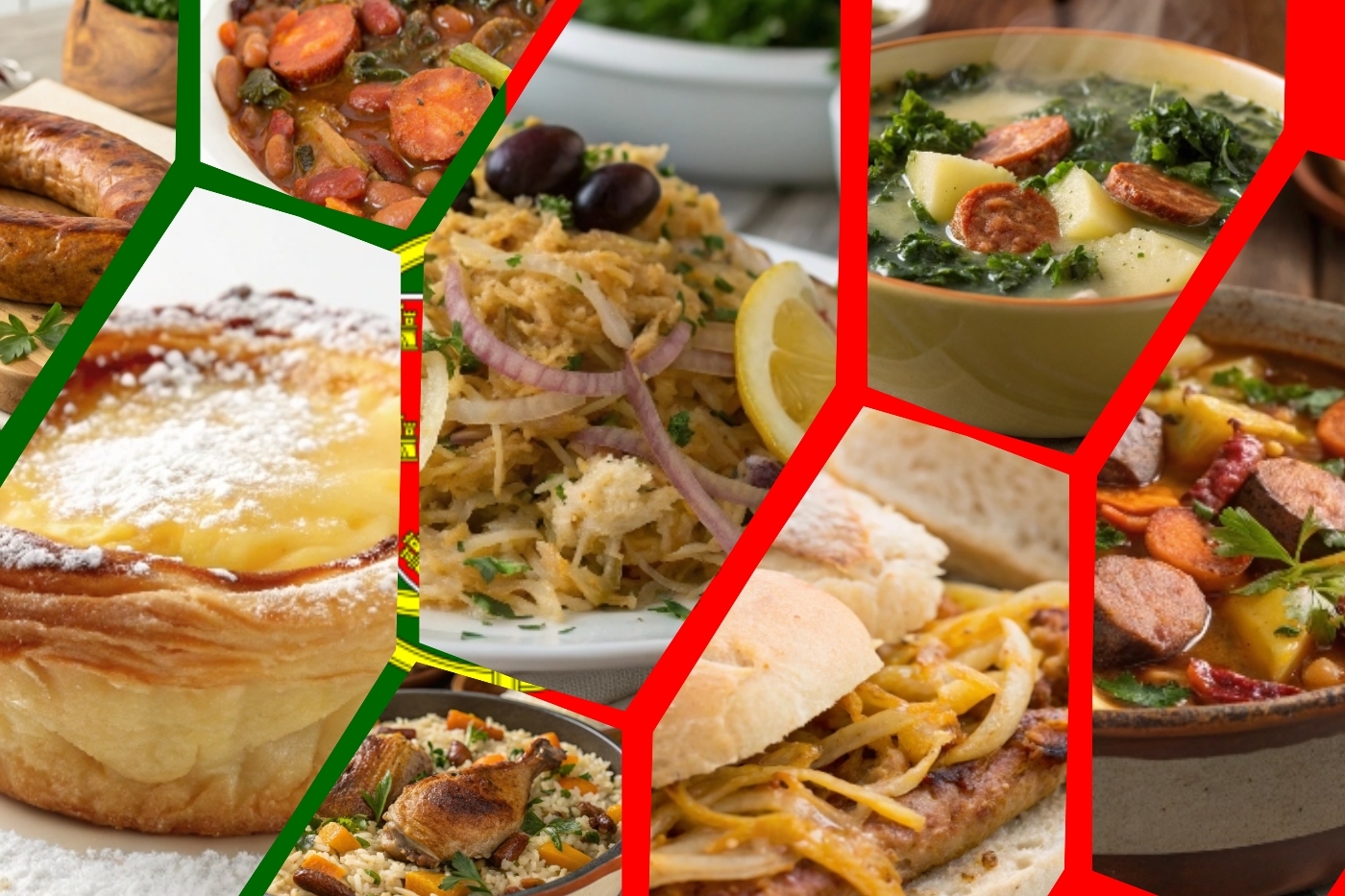Portugal’s culinary tapestry weaves the mesmerizing scent of the Atlantic with generations of tradition, resulting in some of the best portuguese food imaginable. Whether you crave a typical portuguese meal or you’re searching for the national dish of portugal, each offering brims with heartwarming and unforgettable flavors. This gastronomic adventure promises to unite the rustic essence of rural cooking with refined city tastes. Embark on this journey to uncover the secrets, stories, and cultural pride infused into every cherished plate.
From soul-soothing soups to glorious seafood delicacies, Portuguese cuisine is a treasure trove waiting to be discovered. With each bite, you’ll experience an artful interplay of texture and taste, shaped by history and influenced by the country’s proximity to both ocean and farmland. Prepare to lose yourself in deeply succulent morsels of slow-cooked meats, savory pastries, and vibrant and timeless rice-based wonders. As we delve into this flavorful realm, let these adored classics guide you through an unforgettable epicurean escapade.
Table of Contents
Bacalhau à Brás – A Crown Jewel of Best Portuguese Food
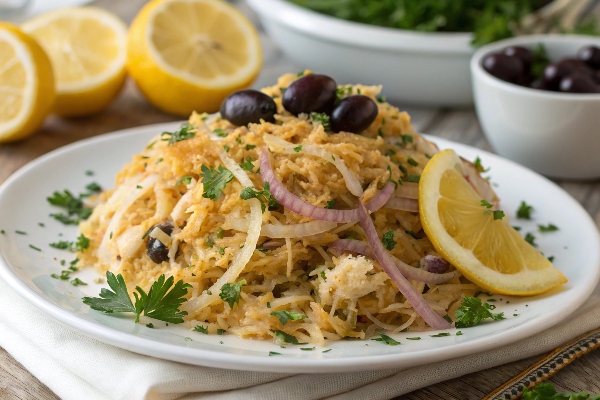
Bacalhau à Brás brings me back to a cozy family gathering in Lisbon, where each forkful felt like a spoonful of sunshine. The delicate strands of salted cod entwined with golden potatoes and onions created a harmony I truly never knew existed. It was love at first bite, a perfect testament to why this is the best portuguese food. Even today, the memory of that savory aroma and the tender crunch in every mouthful warms my heart with nostalgic bliss.
What makes Bacalhau à Brás so enchanting is the subtle interplay of briny fish with the starchy sweetness of potatoes. This typical portuguese meal exudes simplicity, yet delivers immense satisfaction. The onion’s caramelized softness and a sprinkle of fresh parsley add a glorious finishing touch, enhancing the overall mouthfeel. It’s a dish that speaks of old-world charm and ocean-kissed traditions. In each piping-hot serving, you’ll find a delightful balance of flavors, proving that elegance can indeed reside in everyday ingredients.
Preparation, Ingredients, Steps
Bacalhau à Brás might not be the official national dish of portugal, but many locals treat it as a shining symbol of the best portuguese food. Its preparation level is moderate: flake pre-soaked cod, sauté onions and potatoes, then combine everything with eggs until set. Common ingredients include salted cod, potatoes, onions, and eggs. Expect around 450 calories per serving. Gentle stirring is key, and this budget-friendly recipe brings authentic flavors home.
Caldo Verde – Soul-Warming Best Portuguese Food

Caldo Verde reminds me of chilly evenings spent beside my grandmother’s hearth in Porto. The fragrance of simmering collard greens, potatoes, and garlic felt like a comforting embrace. Every spoonful provided a tender lullaby for my taste buds, reaffirming its place among the best portuguese food options. The gentle swirl of olive oil on top added a luxurious richness that warmed me from the inside out. Even today, I can’t help but smile when I recall the heartfelt joy in every sip.
This typical portuguese meal is about humility and satisfaction in a single bowl. Thick, velvety potato broth is the foundation, carrying the essence of farm-fresh greens. In some variations, thinly sliced sausage or hearty meats deepen the flavor, but the soup can stand alone as a wholesome entity. Caldo Verde offers nourishment beyond physical sustenance—its comforting aroma often evokes happy memories and familial gatherings, reminding us that sometimes, the simplest recipes hold the most profound power to soothe and uplift.
Preparation, Ingredients, Steps
Though often overshadowed by the more famous national dish of portugal, Caldo Verde stands proudly among the best portuguese food. This dish is easy to prepare: boil potatoes and onions until soft, blend until creamy, then stir in finely shredded collard greens. Basic ingredients include potatoes, onion, garlic, greens, and optional protein. Each serving has roughly 200 calories. Budget-friendly and simple, it’s the perfect companion on a cold day or any craving for warmth.
Cozido à Portuguesa – A Hearty Homage to Best Portuguese Food
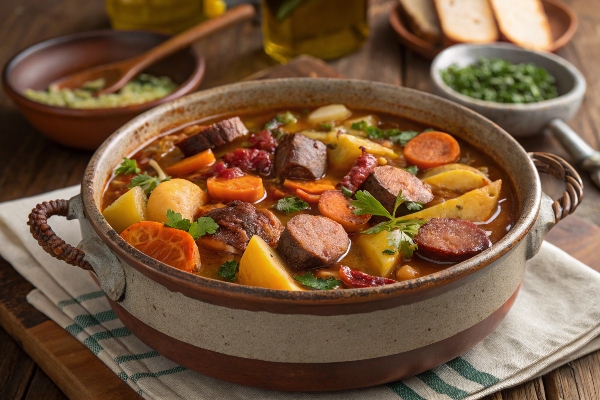
Experiencing Cozido à Portuguesa for the first time felt like uncovering a family secret. The way multiple meats, vegetables, and spices melded into one harmonious stew convinced me that this truly stands among the best portuguese food traditions. There’s a comforting heft to every spoonful, a sense of nurturing that only slow-cooked goodness can provide. In my mind, Cozido is more than just a meal—it’s a celebration of togetherness, brimming with tender morsels that nourish both body and soul.
This typical portuguese meal varies by region and even by household, making it a genuine reflection of the country’s culinary diversity. Some cooks add chicken, others prefer pork or beef, yet each variation retains that signature warmth and depth. Root vegetables like carrots and potatoes soak up the meaty essence, transforming into flavorful gems. The fragrance wafting through the house as it simmers is half the magic. In one pot, Cozido underscores the art of resourceful cooking that brings families together.
Preparation, Ingredients, Steps
While not always labeled as the national dish of portugal, Cozido remains a timeless representative of the best portuguese food. The preparation is moderate: season assorted meats, layer with sturdy vegetables, then simmer until everything becomes fork-tender. Standard ingredients include pork, beef, sausages, potatoes, carrots, and cabbage. One hearty serving averages about 600 calories. Despite its robust presence, the cost remains moderate as it cleverly uses affordable cuts to deliver maximum flavor.
Sardinhas Assadas – The Smoky Coastal Best Portuguese Food
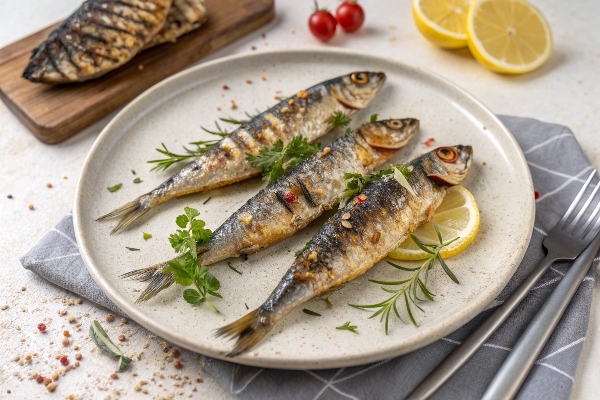
The sizzle and crackle of Sardinhas Assadas on an open grill instantly evokes summer festivals in coastal Portugal. The smoky aroma mingling with the gentle sea breeze is forever etched in my memory. With just a sprinkling of salt, these glistening sardines prove themselves a contender for the best portuguese food. Grasping them by the tail and enjoying every succulent bite feels nostalgic and playful. Those communal lunches by the harbor remain some of my most treasured culinary adventures.
As a typical portuguese meal, Sardinhas Assadas symbolizes Portugal’s deep-rooted connection to the sea. The fish’s natural oils create a melt-in-your-mouth texture when grilled, and the skin crisps to perfection. Pair them with fresh bread or boiled potatoes, and you’ll have a wholesome feast that resonates with vibrant maritime spirit. The simple preparation lets the catch of the day shine, embodying a legacy of fish-focused gastronomy carried proudly by coastal communities for generations, celebrating life’s purity in its most essential form.
Preparation, Ingredients, Steps
Though some might reserve the title of national dish of portugal for other classics, Sardinhas Assadas competes fiercely as a best portuguese food staple. This dish is easy: season fresh sardines with coarse salt, grill on high heat, and serve. Basic ingredients include sardines, salt, and a drizzle of olive oil. Each sardine has about 100 calories. Economical and crowd-pleasing, these smoky gems epitomize the country’s love affair with the ocean’s bounty.
Bifanas – Savory Sandwich of Best Portuguese Food

I recall biting into my first Bifana at a tiny roadside café, juices running down my fingers, and thinking, ‘This might be the best portuguese food ever.’ The pork was so tender it felt like it melted into the fresh roll. The tangy marinade elevated every mouthful, reminding me of comfort food at its finest. Even years later, that simple sandwich remains a benchmark for taste: perfectly balanced, undeniably satisfying, and a testament to Portugal’s flair for flavor.
In many towns, grabbing a Bifana is a typical portuguese meal, quick yet bursting with authenticity. The pork’s subtle marinade can include garlic and paprika, ensuring each bite is aromatic and comforting. Sliding this tender filling into a crusty roll forms a no-fuss dish that can be enjoyed at any hour. Whether devoured as a quick snack during a bustling day or savored slowly with friends, Bifanas capture Portugal’s devotion to honest, down-to-earth cooking that stands the test of time.
Preparation, Ingredients, Steps
Though not officially recognized as the national dish of portugal, Bifanas easily rank among the best portuguese food treasures. The recipe is easy: marinate thin pork slices, sauté with garlic and spices, then tuck them into a crusty roll. Key ingredients include pork loin, garlic, paprika, and salt. Each sandwich has roughly 400 calories. This budget-friendly treat is a testament to how minimal ingredients can yield maximum deliciousness.
Arroz de Pato – Rice Richness in Best Portuguese Food

Arroz de Pato conjures images of family reunions where the table overflowed with talk and laughter. The first mouthful of succulent duck, nestled among perfectly seasoned rice, convinced me I was tasting the best portuguese food. There’s a harmony between the tender shreds of poultry and the grains that soak up every drop of flavor. With each forkful, I felt gratitude for the care and patience poured into creating this aromatic masterpiece that still resonates in my mind today.
This typical portuguese meal captures the essence of slow, deliberate cooking. The rice is often baked with duck stock and spices, producing a crispy top layer that contrasts beautifully with the moist interior. Some families include chouriço or vegetables for added depth, but the star remains the richly infused duck. This dish is comfort incarnate, bringing warmth to festive gatherings or special Sunday lunches. The layered flavors reflect a meticulous craft that reveals the culinary heart of Portuguese homes.
Preparation, Ingredients, Steps
“While others may champion another recipe as the national dish of portugal, Arroz de Pato demands recognition among the best portuguese food creations. The preparation is moderate: boil duck until tender, shred the meat, sauté rice in the broth, and bake. Essential ingredients include duck, rice, onion, and spices. Expect around 550 calories per serving. Although it’s slightly pricier due to the duck, its sumptuous taste justifies every moment and penny.
Feijoada à Portuguesa – A Comforting Stew of Best Portuguese Food
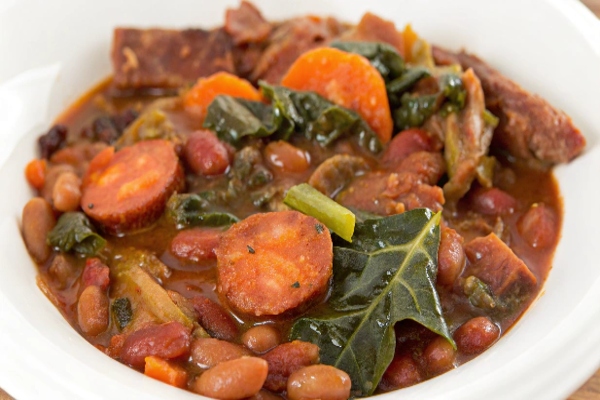
Tucking into a bowl of Feijoada à Portuguesa feels like receiving a warm hug on a chilly day. The rich, velvety bean stew brimming with meat morsels always reminds me of home. It’s among the best portuguese food experiences because it radiates comfort with each spoonful, inviting you to sit down, unwind, and cherish the moment. My grandmother’s kitchen often smelled of simmering Feijoada, and even now, the memory of its savory aroma conjures images of familial laughter and shared affection.
This typical portuguese meal is a hearty celebration of beans, typically white or red, combined with flavorful cuts of pork or beef. Vegetables like carrots and cabbage enrich the stew’s texture, turning every bite into a savory mosaic. In some regions, extra herbs or spices sneak in, adding subtle complexities. Though it’s a substantial plate, Feijoada carries a down-home warmth that nourishes both body and soul. One taste unveils the layers of tradition and the significance of communal dining.
Preparation, Ingredients, Steps
Some claim Feijoada deserves the spotlight as the national dish of portugal, and it unquestionably belongs in any best portuguese food lineup. Preparing it is moderate: soak beans, stew them alongside seasoned meats, and let flavors meld gently. Common ingredients include beans, pork, beef, onions, carrots, and cabbage. Around 500 calories per bowl, it’s a cost-effective way to feed a family. Feijoada thrives on patience, rewarding you with irresistible coziness.
Frango no Churrasco – Fiery Grilled Best Portuguese Food
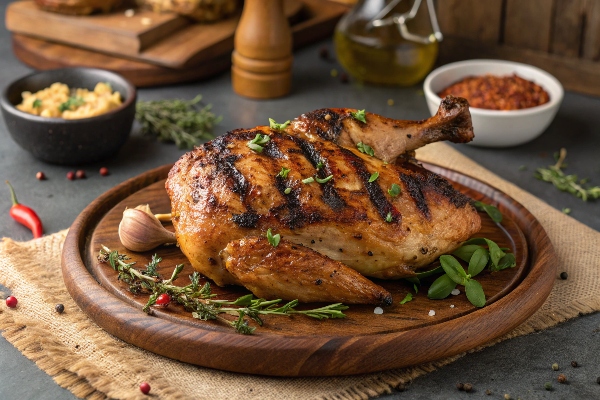
The fiery crackle of Frango no Churrasco on a charcoal grill always awakens my appetite. The succulent chicken, bathed in fragrant seasonings, emerges with smoky char that sets it apart as the best portuguese food. My earliest memory involves watching the flames dance around the spatchcocked bird, mesmerized by the sizzling skin. Tasting that tender, spice-kissed chicken felt like an epiphany—flavorful, juicy, and carrying the warmth of a summertime feast into every single bite.
As a typical portuguese meal choice for family gatherings, Frango no Churrasco epitomizes Portugal’s penchant for grilled perfection. Marinated with garlic, paprika, and sometimes piri-piri pepper, the chicken attains a signature fiery edge without overwhelming heat. Whether served with fries, rice, or a fresh salad, it remains versatile and crowd-pleasing. The communal act of outdoor grilling, with chatter and laughter filling the air, adds to the overall experience, proving that the simplest approach can yield deeply satisfying results.
Preparation, Ingredients, Steps
Though not officially crowned the national dish of portugal, Frango no Churrasco holds its place among the best portuguese food icons. Preparation is easy: butterfly the chicken, marinate with spices, then grill on medium-high heat until cooked through. Primary ingredients include whole chicken, garlic, paprika, and salt. Each serving averages 350 calories. With modest costs and minimal fuss, this beloved staple proves that traditional grilling never goes out of style.
Alheira de Mirandela – Smoky Sausage of Best Portuguese Food
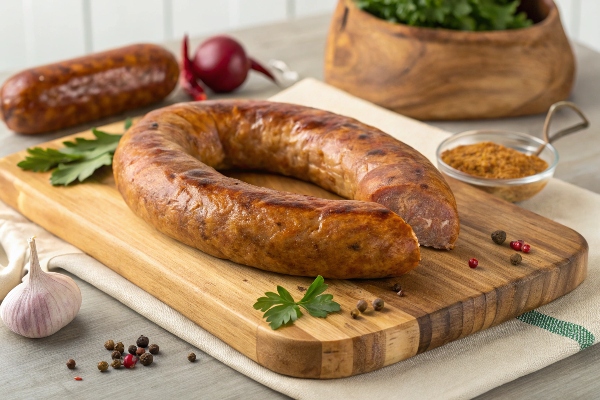
My first taste of Alheira de Mirandela was a pleasant surprise. I expected an ordinary sausage but discovered a symphony of bread, poultry, and garlic, affirming its status among the best portuguese food. Slightly smoky with an inviting texture, it elevated the meaning of comfort on my plate. In the rural tavern where I tried it, locals explained the sausage’s deep roots, and I felt an immediate connection to the land and its resourceful heritage of flavor innovation.
This typical portuguese meal reveals its history in every bite. Originally crafted by Jewish communities to appear like standard pork sausages, Alheira relies primarily on poultry and bread as its base. The result is an intensely savory link that can be grilled or pan-fried, often served with fries or vegetables. Crisping its exterior creates a delectable contrast to the soft interior. Each luscious piece tells a story of adaptation and resilience—an homage to Portugal’s multicultural influences wrapped in golden casings.
Preparation, Ingredients, Steps
Although not deemed the national dish of portugal, Alheira is undeniably a gem among the best portuguese food. Preparation is easy: simply heat the sausage in a skillet or grill. Main components include poultry, bread, and garlic, though variations exist. With around 300 calories per link, it’s moderate on the waist and wallet. Alheira proves that authentic flavors and cultural narratives can be savored in the simplest of forms.
Pastel de Nata – Sweet Finale of Best Portuguese Food

Taking a bite of a freshly baked Pastel de Nata is an experience that transcends dessert—it’s a revelation in the best portuguese food realm. The flaky crust shatters delicately, unveiling a silky custard that envelopes your senses in warmth. With a dusting of cinnamon or powdered sugar on top, I remember savoring these pastries at a bustling café in Belém, each mouthful lighting up my face with unbridled delight.
Though sweet, Pastel de Nata often concludes a typical portuguese meal with a final flourish of indulgence. The custard’s subtle sweetness balances the buttery layers of pastry, creating an exquisite union of textures. Biting in, you’ll sense a gentle caramelization on top, reminiscent of crème brûlée, yet uniquely Portuguese in character. Whether enjoyed with a cup of coffee or as a spontaneous treat, these tarts remind us of Portugal’s deep-rooted love affair with simple, yet flawlessly executed, baking techniques.
Preparation, Ingredients, Steps
Many travelers consider Pastel de Nata an unofficial national dish of portugal, solidifying its place among the best portuguese food. It’s a moderate recipe: line a muffin tin with puff pastry, then fill with an egg-based cream and bake at high heat. Basic ingredients include puff pastry, eggs, sugar, and milk. Each tart contains about 200 calories. While pastries might be a splurge, the blissful flavor is priceless, marking a sweet farewell.
Conclusion
From the earthy warmth of Cozido à Portuguesa to the sweet temptation of Pastel de Nata, the best portuguese food dazzles at every turn. Each typical portuguese meal tells a tale of heritage, culture, and the passion that shapes Portugal’s culinary identity. The essence of sea, land, and tradition merges in dishes that captivate hearts worldwide. Whether you crave rustic comfort or refined indulgence, these time-honored recipes promise an unforgettable dining experience, proving why Portugal’s gastronomic legacy remains cherished through generations.
As we savor the last bites of Portugal’s finest flavors, our culinary adventure doesn’t end here. Just beyond the Iberian border lies another gastronomic wonderland—Italy. From the rolling hills of Tuscany to the bustling streets of Naples, every region offers a soul-stirring feast that speaks of history, passion, and artistry. Get ready to embark on an irresistible culinary journey as we unveil the 10 must-try iconic foods that define the heart and soul of Italian cuisine.
What is the national dish of Portugal?
Portugal’s national dish is Bacalhau, or salted cod, which is said to have over 1,000 different preparations. One of the most famous versions is Bacalhau à Brás, a comforting dish of flaked cod, golden potatoes, onions, and eggs.
What is a typical Portuguese meal?
A typical Portuguese meal often consists of fresh seafood, grilled meats, hearty stews, and rice-based dishes. Meals usually start with bread, olives, and cheese, followed by a main dish like Cozido à Portuguesa or Arroz de Pato, and end with a classic dessert like Pastel de Nata.
What is the most famous Portuguese dessert?
The most famous Portuguese dessert is Pastel de Nata, a creamy, flaky custard tart with a caramelized top. It pairs perfectly with an espresso, known as bica, making it a must-try sweet treat in Portugal.
Is Portuguese food spicy?
Portuguese food is not generally spicy, but it is rich in bold flavors. The country’s cuisine relies heavily on garlic, olive oil, paprika, and fresh herbs. However, if you’re looking for heat, try Frango Piri-Piri, a grilled chicken dish marinated in spicy chili sauce.
What are some budget-friendly Portuguese dishes to try?
Some budget-friendly Portuguese dishes include Caldo Verde (a hearty green soup), Bifanas (savory pork sandwiches), and Sardinhas Assadas (grilled sardines). These dishes are flavorful, filling, and commonly found in casual eateries and street markets.

